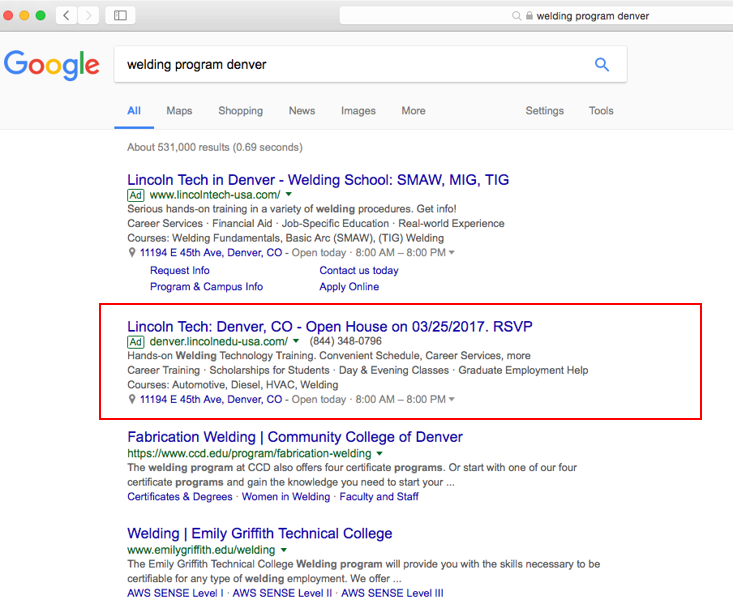
By Dr. Andy Beedle, Chief Digital Strategist, Norton|Norris, Inc.
The first couple months of the year have come and gone. The elation of January’s massive influx of traffic has been replaced by February’s “time to clean up after the party” blues. But don’t despair – the digital outlook for 2017 looks brighter than ever, and we are here to give you some solid (and easy-to-execute) tactics that will improve your results.
To give you a well-rounded toolkit, we’ll be giving you some pay-per-click tips by covering three features of AdWords that can change the game for you. Then we’ll dive into social media and show you two killer tactics that can yield significant gains in engagement with your profile page. Finally, we’ll address SEO by talking a little bit about Google algorithm updates and what to do about them.
AdWords features you didn’t know you loved
Not only is Google’s AdWords platform the best source of high-quality paid traffic on the Internet, but it is also a treasure trove of tools and features that can help you broaden your reach, fine-tune your campaigns, and grow your prospect pool.
The ad label trick
As little as two years ago, it was much easier to differentiate paid content from organic search results (see Figure 1). This format soon gave way to one tiny badge at the top left of the headline that said “Ad.” Last year, this badge went from being the same blue as the ad’s headline to being the same green color that Google uses to display the links in search results.
Figure 1 – Old Google Ads
While the “Ad” label was a great way to distinguish paid content from natural search results, this change meant that the label sort of blended in with the link itself. This made ads look just a little bit more like organic search results than they had previously.
Well, Google just changed the label again. This time, it is merely a green outline around green text that reads “Ad” (see Figure 2).
Figure 2 – New Ad Label
In short, it’s harder than ever to scan a page and see the difference between an ad and organic search results (see Figure 3).
Figure 3 – Ad vs. Organic Search Result (Mobile)
So, how does this influence your ad campaigns? Our research shows that second position ads are generating fewer clicks with “intent” (i.e., users knew they were clicking an ad) than those in the top position.
The Norton|Norris digital team has always strongly advocated for high ad placement positions. Now we work to not only dominate the top slot, but also bid to intentionally put competitors’ ads in position #2 while keeping our clients out of that position.
The Tip: Making sure your average position eliminates as many “#2” positioned ads as possible will be an ever more important strategy in generating quality clicks from users who are interested in your programs and know that they are engaging with an ad (see Figure 4).
Figure 4 – Position 2 Ad
Expanded text ads
Google rolled out a new text ad format to all accounts late last year. The new “Expanded” text ads change the length of your headline (making it longer by adding an extra line). They also give you a longer area for your ad’s descriptive text (see Figure 5).
Figure 5 – Expanded Text Ad
These changes, in addition to the judicious and thorough use of ad extensions, mean that your ads get more screen real estate when served. What’s not to love?
While the initial roll out showed that the old-style text ads were outperforming the new expanded text ads, as mobile traffic continued to grow at the end of the year, the expanded ads showed superior click-thru and conversion rates.
The Tip: Google announced that as of Jan. 31 of this year, accounts would no longer be able to create additional old style text ads and all new ads would have to be in the expanded text ad format. If you haven’t done so already, it’s time to start introducing expanded text ads to your account and phasing out the old style ads over the next couple of months. You’ll be glad you did!
The chat extension
AdWords allows advertisers to create ‘extensions’ that expand the functionality of their ads. Typical extensions include addresses for local campuses, phone numbers to enable click-to-call, and sitelinks that allow users to interact with particular topics on the advertiser’s website.
After a large scale Beta last year, Google has introduced click-to-message extensions to most accounts nationwide (see Figure 6).
Figure 6 – Setup for Adwords Chat Extension
Tapping on the texting option launches a user’s SMS app with a pre-written message tailored to the product or service they’re interested in. For example, if you’re a travel advertiser and someone messages you after searching for New York City hotels, they can send or edit your pre-written message text, “I’m interested in a reservation. Please text me back with more information.”
The Tip: If you have a robust chat system in place in your admissions department, then you can imagine how powerful this extension can be for event RSVPs, tour scheduling, and appointment setting. Go nuts!
Two Facebook tricks to drive engagement
Social media is such a tough channel for the education sector. Here are two things you can do to expand your reach into the newsfeed of those who have “liked” your page.
Invite people to the party!
Whenever you post on Facebook, the system keeps track of how many people have “liked” the content you’ve shared. Many times, those people have already followed your page. However, any time you have content that is shared, it is highly likely that those additional likes are from people who have never interacted with your social media presence before.
When someone has liked your content, but does not “follow” your page, they are MUCH less likely to ever see your additional content in their newsfeed. If a user likes your content and then subsequently follows your page, Facebook sees this as a major sign of interest and engagement, pushing your content into their newsfeed at a MUCH higher rate.
Wouldn’t it be great to turn those “likes” into page followers?
The Tip: Whenever you post content, wait a few days and pull up the list of “likes” for that post. You can do this by clicking on the number next to the little blue “thumbs up” icon. When you do this, you’ll get a list of people who liked that post (see Figure 7). Those who don’t already follow your page have an “invite” button next to them … You know what to do next.
Figure 7 – Turn “Likes” to “Follows”
Pay for the privilege
You see less than 3 percent of what is posted by your Facebook friends. Think about that for a moment. If you have, say 150 friends on Facebook (a relatively small number), you are seeing only the smallest fraction of the content those people post. Ditto the pages you follow.
Over time, the situation gets “worse” in that you will be shown MORE of the content that is similar to what you interact with (read, listen to, click on, etc.) This means that more and more individual sources will drop out of your newsfeed and you will interact with fewer posters.
But … Facebook is in the business of making money. And Facebook ads are relatively cheap. You can “pay to play” and get your content in front of far more people by posting targeted ads rather than relying on your main page.
The Tip: Start a Facebook ad campaign and use your best content there. BUT DO NOT “BOOST” POSTS (see Figure 8). Boosted posts are the least effective and least targeted types of Facebook ads. Instead, create age/geo-targeted ads to appear inside the newsfeed and share your best content there. These ads generate likes and comments just like regular posts. Once your ad has been live for a while, you can refer to the tip above and turn those likes into followers!
Figure 8 – Do NOT Boost Post
Google updates and what to do about them
I must confess our Digital team is a collection of nerds – myself included. And very few things are nerdier than eagerly reading through online forums to sleuth out the latest developments in Google’s search algorithm.
During the first week of February, those of us who watch these things obsessively noticed that several websites took huge rankings losses on terms and keywords with which they have previously done quite well.
Even more puzzling was that these sites were not the typical offenders (affiliate marketers, linkbait content farms, and so forth). Instead, they were fairly reputable and well-presented sites that hadn’t done anything “wrong” in terms of trying to manipulate search results.
When these sorts of mass ranking changes occur, those of us in the Search Engine Optimization field know one thing: Google has pushed another update to its algorithm live.
In this case, the update was unannounced and unacknowledged. What to do? Wait it out and see if the rankings changes are “permanent” and if they are (which you can see after a couple of weeks), formulate a strategy based on the new search reality. If they are not permanent, no harm was done and go on as usual.
The Tip: Someone in your organization needs to stay on top of Google’s search engine changes. Some changes are announced well in advance (like the privileging of mobile content and sites over desktop only) and some are introduced with no fanfare and even less public discussion. You need to know when changes occur and then watch to see if they are permanent or resolve themselves as Google fine-tunes their updates.
And there you have it! Some simple tips and ideas to help get the rest of your digital marketing year moving. As always, our Digital Group is happy to talk about your school’s challenges and opportunities. Just give us a call or email info@nortonnorris.com to set up an appointment.
DR. ANDY BEEDLE, Chief Digital Strategist at Norton|Norris, has been developing and managing successful online campaigns for colleges since 1998. During his academic career, he published research in the Journal for Neuroscience Research, The American Philosophical Quarterly, and the Journal of Philosophical Psychology (among others). He also delivered conference papers and various invited lectures.
He has contributed to the marketing field with presentations at national conferences ranging from NACAC to the National Small College Enrollment Conference as well as industry sponsored symposia and engagements with individual Colleges and Universities. In addition to speaking and writing on enrollment management and the growth of the Internet, he has been interviewed by numerous publications including the Atlantic Monthly, Inside Higher Ed, the Lawlor Review, the Admissions Marketing Report, and U.S. News and World Report.
An avid foodie, if he’s not working with Nn’s digital team, he is likely at a restaurant or in the kitchen whipping up a meal for friends and family.
Contact Information: Dr. Andrew Beedle // Chief Digital Strategist // Norton|Norris // 540-520-3221 // andy@nortonnorris.com // http://nortonnorris.com



















